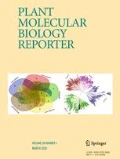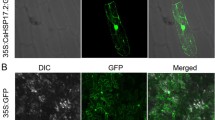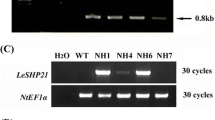Abstract
The chloroplast small heat shock proteins (Cp-sHSP) protect photosystem II and thylakoid membranes during heat and other types of stresses. The amount of Cp-sHSPs produced is correlated with plant thermotolerance. Cp-sHSPs of Chenopodium album have already been shown to be heat-regulated and have a novel promoter architecture containing some conserved regulatory motifs Shakeel et al. (Plant Physiol Biochem 49:898–908, 2011). To determine if similar or different Cp-sHSP isoforms protect plants against heat and metal stress, we isolated and characterized a novel Cp-sHSP isoform, CaHSP26.13p (GI # JX073659) from a Pakistani C. album ecotype and determined its expression under heat and metal stress by measuring transcript and protein levels. Presence of the same CaHSP26.13p transcript in heat- and metal-treated plants provided evidence of heat- and metal-regulated expression. Gene expression analysis indicated that Cp-sHSP transcript levels were maximum at 37 °C for 4 h (heat stress) and 20 mM cadmium (metal stress). Immunoblot analysis revealed that (1) maximum expression of precursor and processed protein was observed at 37 °C in the case of heat stress, (2) while only precursor protein of ~26 kDa was produced in the case of metal stress. The highest expression occurred when plants were treated with 15 mM cadmium. We speculate that post-translational regulation accounted for the lack of correlation between transcript and protein levels. This study demonstrates that differential regulation of the same C. album Cp-sHSP family member enables it to play a dual role in protecting the plant from heat and metal stress.




Similar content being viewed by others
References
Alam MM, Hayat S, Ali B, Ahmad A (2007) Effect of 28-homobrassinolide treatment on nickel toxicity in Brassic juncea. Photosynthetica 45:139–142
Almoguera C, Prieto-Dapena P, Jordano J (1998) Dual regulation of a heat shock promoter during embryogenesis: stage-dependent role of heat shock elements. Plant J 13:437–446
Amin J, Ananthan J, Voellmy R (1988) Key features of heat shock regulatory elements. Mol Cell Biol 8:3761–37619
Ashby RS, Megaw PL, Morgan IG (2009) Changes in retinal alpha B-crystallin (cryab) RNA transcript levels during periods of altered ocular growth in chickens. Exp Eye Res 90:238–243
Balestrasse KB, Tomaro ML, Batlle A, Noriega GO (2010) The role of 5-aminolevulinic acid in the response to cold stress in soybean plants. Phytochemistry 71:2038–2045
Banti V, Loreti E, Novi G, Santaniello A, Alpi A, Perata P (2008) Heat acclimation and cross-tolerance against anoxia in Arabidopsis. Plant Cell Environ 31:1029–1037
Barua D, Downs CA, Heckathorn SA (2003) Variation in chloroplast small heat-shock protein function is a major determinant of variation in thermotolerance of photosynthetic electron transport among ecotypes of Chenopodium album. Funct Plant Biol 30:1071–1079
Barua D, Heckathorn SA, Coleman JS (2008) Variation in heat-shock proteins and photosynthetic thermotolerance among natural populations of Chenopodium album L. from contrasting thermal environments: implications for plant responses to global warming. J Integr Plant Biol 50:1440–1451
Beauchamp C, Fridovich I (1971) Superoxide dismutase: improved assay and an assay applicable to acrylamide gels. Anal Biochem 44:276–287
Bekesiova B, Hraska S, Libantova J, Moravcikova J, Matusikova I (2008) Heavy-metal stress induced accumulation of chitinase isoforms in plants. Mol Biol Rep 35:579–588
Chen Q, Vierling E (1991) Analysis of conserved domains identifies a unique structural feature of a chloroplast heat shock protein. Mol Gen Genet 226:425–431
Chen CH, Zhou QX, Cai Z, Wang YY (2010) Effects of soil polycyclic musk and cadmium on pollutant uptake and biochemical responses of wheat (Triticum aestivum). Arch Environ Contam Toxicol 59:564–573
Clemens S (2006) Toxic metal accumulation, responses to exposure and mechanisms of tolerance in plants. Biochimie 88:1707–1719
Cobbett CS (2000) Phytochelatins and their roles in heavy metal detoxification. Plant Physiol 123:825–832
Colinet H, Lee SF, Hoffmann A (2009) Temporal expression of heat shock genes during cold stress and recovery from chill coma in adult Drosophila melanogaster. FEBS Lett 277:174–185
Dong J, Wu FB, Zhang GP (2005) Effect of cadmium on growth and photosynthesis of tomato seedlings. J Zhejiang Univ Sci B 6:974–980
Downs CA, Heckathorn SA (1998) The mitochondrial small heat-shock protein protects NADH:ubiquinone oxidoreductase of the electron transport chain during heat stress in plants. FEBS Lett 430:246–250
Downs CA, Ryan SL, Heckathorn SA (1999) The chloroplast small heat-shock protein: evidence for a general role in protecting photosystem II against oxidative stress and photoinhibition. J Plant Physiol 155:488–496
Drazkiewicz M, Skozynska-Polit E, Wanke M, Swiezewska E (2003) The activity of antioxidant enzymes in Arabidopsis thaliana exposed to colchicine and H2O2. Cell Mol Biol Lett 8:777–781
Gajewska E, Sklodowska M (2007) Effect of nickel on ROS content and antioxidative enzyme activities in wheat leaves. BioMetals 20:27–36
Gorin N, Heidema FT (1976) Peroxidase activity in golden delicious apples as a possible parameter of ripening and senescence. J Agric Food Chem 24:200–201
Guan JC, Yeh CH, Lin YP, Ke YT, Chen MT, You JW, Liu YH, Lu CA, Wu SJ, Lin CY (2010) A 9 bp cis-element in the promoters of class I small heat shock protein genes on chromosome 3 in rice mediates l-azetidine-2-carboxylic acid and heat shock responses. J Exp Bot 61:4249–4261
Guo SJ, Zhou HY, Zhang XS, Li XG, Meng QW (2007) Overexpression of CaHSP26 in transgenic tobacco alleviates photoinhibition of PSII and PSI during chilling stress under low irradiance. J Plant Physiol 164:126–136
Hall JL (2002) Cellular mechanisms for heavy metal detoxification and tolerance. J Exp Bot 53:1–11
Hamilton EW, Heckathorn SA (2001) Mitochondrial adaptations to NaCl. Complex I is protected by anti-oxidants and small heat shock proteins, whereas complex II is protected by proline and betaine. Plant Physiol 126:1266–1274
Haralampidis K, Milioni D, Rigas S, Hatzopoulos P (2002) Combinatorial interaction of cis elements specifies the expression of the Arabidopsis AtHsp90-1 gene. Plant Physiol 129:1138–1149
Heckathorn SA, Downs CA, Sharkey TD, Coleman JS (1998) The small, methionine-rich chloroplast heat-shock protein protects photosystem II electron transport during heat stress. Plant Physiol 116:439–444
Heckathorn SA, Ryan SL, Baylis JA, Wang D, Hamilton IEW, Cundiff L, Luthe DS (2002) In vivo evidence from an Agrostis stolonifera selection genotype that chloroplast small heat-shock proteins can protect photosystem II during heat stress. Funct Plant Biol 29:933–944
Heckathorn SA, Mueller JK, LaGuidice S, Zhu B, Barrett T, Blair B, Dong Y (2004) Chloroplast small heat-shock proteins protect photosynthesis during heavy metal stress. Am J Bot 91:1312–1318
Hiscox JD, Israelstam GF (1979) A method for the extraction of chlorophyll from leaf tissue without maceration. Can J Bot 57:1332–1334
Huang GY, Wang YS (2010) Physiological and biochemical responses in the leaves of two mangrove plant seedlings (Kandelia candel and Bruguiera gymnorrhiza) exposed to multiple heavy metals. J Hazard Mater 182:848–854
Huang B, Xu C (2008) Identification and characterization of proteins associated with plant tolerance to heat stress. J Integr Plant Biol 50:1230–1237
Kirkham MB (2006) Cadmium in plants on polluted soil: effects of soil factors, hyperaccumulation, and amendments. Geoderma 137:19–32
Kováèik J, Klejdus B, Hedbavny J, Štork F, Baèkor M (2009) Comparison of cadmium and copper effect on phenolic metabolism, mineral nutrients and stress-related parameters in Matricaria chamomilla plants. Plant Soil 320:231–242
Krantev A, Yordanova R, Janda T, Szalai G, Popova L (2008) Treatment with salicylic acid decreases the effect of cadmium on photosynthesis in maize plants. J Plant Physiol 165:920–931
Li EH, Miles CD (1975) Effects of cadmium on photoreaction II of chloroplasts. Plant Sci Lett 5:33–40
Liu X, Huang B (2000) Heat stress injury in relation to membrane lipid peroxidation in creeping bentgrass. Crop Sci 40:503–510
Metwally A, Safronova VI, Belimov AA, Dietz KJ (2005) Genotypic variation of the response to cadmium toxicity in Pisum sativum L. J Exp Bot 56:167–178
Nakamoto H, Suzuki N, Roy SK (2000) Constitutive expression of a small heat-shock protein confers cellular thermotolerance and thermal protection to the photosynthetic apparatus in cyanobacteria. FEBS Lett 483:169–174
Neta-Sharir I, Isaacson T, Lurie S, Weiss D (2005) Dual role for tomato heat shock protein 21: protecting photosystem II from oxidative stress and promoting color changes during fruit maturation. Plant Cell 17:1829–1838
Osteryoung KW, Vierling E (1994) Dynamics of small heat shock protein distribution within the chloroplasts of higher plants. J Biol Chem 269:28676–28682
Park S-Y, Shivaji R, Krans JV, Luthe DS (1996) Heat shock response in heat tolerant and non-tolerant variants of Agrostis palustris. Plant Physiol 111:515–524
Pavlikova D, Pavlik M, Staszkova L, Motyka V, Szakova J, Tlustos P, Balik J (2008) Glutamate kinase as a potential biomarker of heavy metal stress in plants. Ecotoxicol Environ Saf 70:223–230
Perisic O, Xiao H, Lis JT (1989) Stable binding of Drosophila heat shock factor to head-to-head and tail-to-tail repeats of a conserved 5 bp recognition unit. Cell 59:797–806
Preczewski P, Heckathorn SA, Downs CA, Coleman JS (2000) Photosynthetic thermotolerance is positively and quantitatively correlated with production of specific heat-shock proteins among nine genotypes of tomato. Photosynthetica 38:127–134
Ralph PJ, Burchett MD (1998) Photosynthetic response of Halophila ovalis to heavy metal stress. Environ Pollut 103:91–101
Sabehat A, Lurie S, Weiss D (1998) Expression of small heat-shock proteins at low temperatures. Plant Physiol 117:651–658
Scott I, Logan DC (2008) Mitochondrial morphology transition is an early indicator of subsequent cell death in Arabidopsis. New Phytol 177:90–101
Shakeel S, Haq NU, Heckathorn SA, Hamilton EW, Luthe DS (2011) Ecotypic variation in chloroplast small heat-shock proteins and related thermotolerance in Chenopodium album. Plant Physiol Biochem 49:898–908
Smeets K, Cuypers A, Lambrechts A, Semane B, Hoet P, Van Laere A, Vangronsveld J (2005) Induction of oxidative stress and antioxidative mechanisms in Phaseolus vulgaris after Cd application. Plant Physiol Biochem 43:437–444
Sun W, Bernard C, van de Cotte B, Van Montagu M, Verbruggen N (2001) At-HSP17.6A, encoding a small heat-shock protein in Arabidopsis, can enhance osmotolerance upon overexpression. Plant J 27:407–415
Sun W, Van Montagu M, Verbruggen N (2002) Small heat shock proteins and stress tolerance in plants. Biochim Biophys Acta 1577:1–9
Torok Z, Goloubinoff P, Horvath I, Tsvetkova NM, Glatz A, Balogh G, Varvasovszki V, Los DA, Vierling E, Crowe JH, Vigh L (2001) Synechocystis HSP17 is an amphitropic protein that stabilizes heat-stressed membranes and binds denatured proteins for subsequent chaperone-mediated refolding. Proc Natl Acad Sci U S A 98:3098–3103
Valcu CM, Lalanne C, Plomion C, Schlink K (2008) Heat induced changes in protein expression profiles of Norway spruce (Picea abies) ecotypes from different elevations. Proteomics 8:4287–4302
Vetter JL, Steinberg MP, Nelson AI (1958) Quantitative determination of peroxidase in sweet corn. J Agric Food Chem 6:39–41
Vierling E (1991) The roles of heat shock proteins in plants. Annu Rev Plant Physiol Plant Mol Biol 42:579–620
Vinit-Dunand F, Epron D, Alaoui-Sossé B, Badot PM (2002) Effects of copper on growth and on photosynthesis of mature and expanding leaves in cucumber plants. Plant Sci 163:53–58
Wang D, Luthe DS (2003) Heat sensitivity in a bentgrass variant. Failure to accumulate a chloroplast heat shock protein isoform implicated in heat tolerance. Plant Physiol 133:319–327
Wang D, Barua D, Joshi P, LaCroix J, Hamilton EW, Heckathorn SA (2008) Effects of elevated CO2 on the tolerance of photosynthesis to acute heat stress in 11 (C3, C4, and CAM) species. Am J Bot 95:1–13
Wehmeyer N, Hernandez LD, Finkelstein RR, Vierling E (1996) Synthesis of small heat-shock proteins is part of the developmental program of late seed maturation. Plant Physiol 112:747–757
Xiao H, Lis JT (1988) Germline transformation used to define key features of heat-shock response elements. Science 239:1139–1142
Xiao H, Perisic O, Lis JT (1991) Cooperative binding of Drosophila heat shock factor to arrays of a conserved 5 bp unit. Cell 64:585–593
Xu S, Li J, Zhang X, Wei H, Cui L (2006) Effects of heat acclimation pretreatment on changes of membrane lipid peroxidation, antioxidant metabolites, and ultra structure of chloroplast in two cool-season turfgrass species under heat stress. Environ Exp Bot 56:274–285
Zhang J, Stewart JMD (2000) Economical and rapid method for extracting cotton genomic DNA. J Cotton Sci 4:193–201
Zhu Y, Zhu J, Wan X, Zhang T (2010) Gene expression of sHsps, Hsp40 and Hsp60 families in normal and abnormal embryonic development of mouse forelimbs. Toxicol Lett 193:242–251
Acknowledgments
This research was fully supported by the Higher Education Commission of Pakistan (grant # 1212) to SNS. We thank Dr. Eric Schaller for giving us opportunity to complete some of the critical experiments in his lab. We also thank the reviewers for their excellent suggestions to improve the manuscript.
Author information
Authors and Affiliations
Corresponding author
Rights and permissions
About this article
Cite this article
Haq, N.U., Raza, S., Luthe, D.S. et al. A Dual Role for the Chloroplast Small Heat Shock Protein of Chenopodium album including Protection from Both Heat and Metal Stress. Plant Mol Biol Rep 31, 398–408 (2013). https://doi.org/10.1007/s11105-012-0516-5
Published:
Issue Date:
DOI: https://doi.org/10.1007/s11105-012-0516-5




